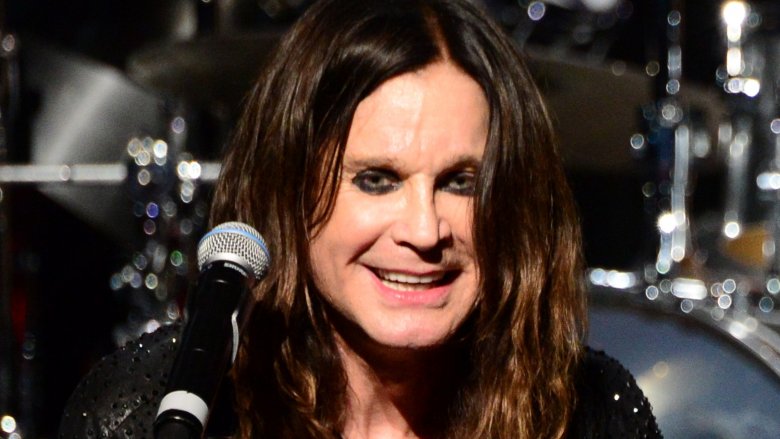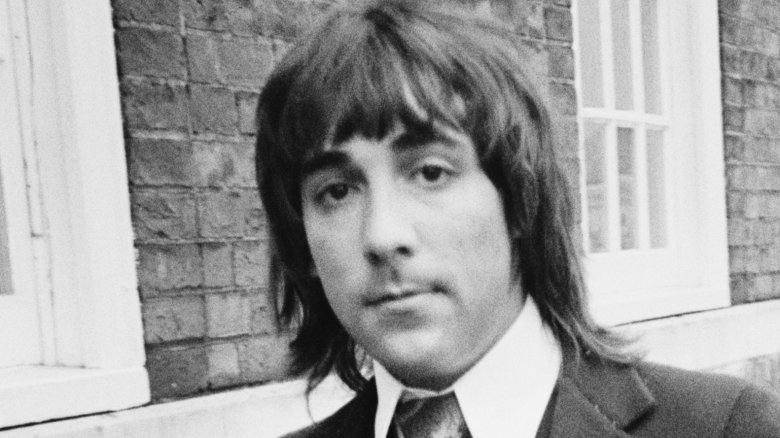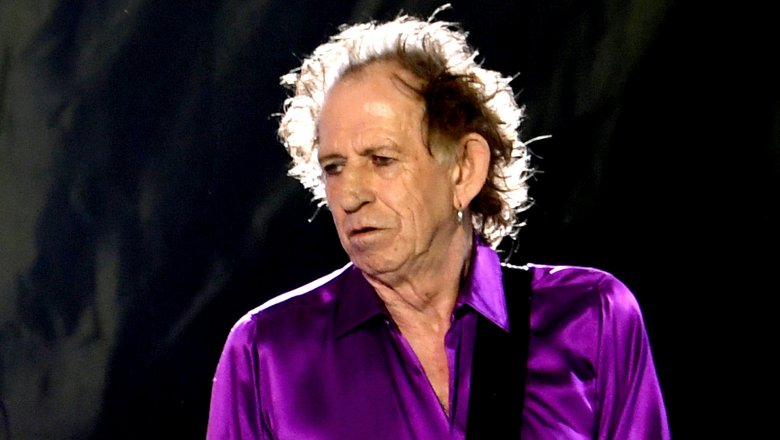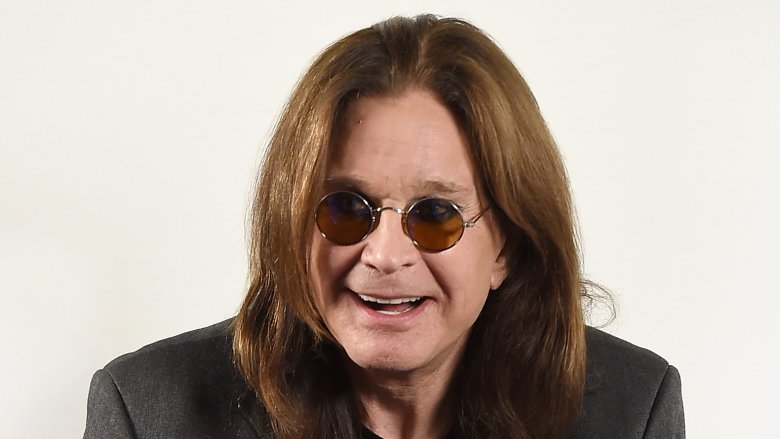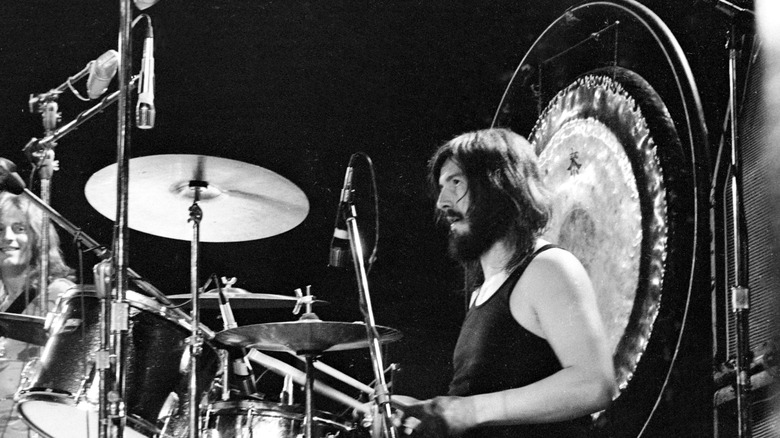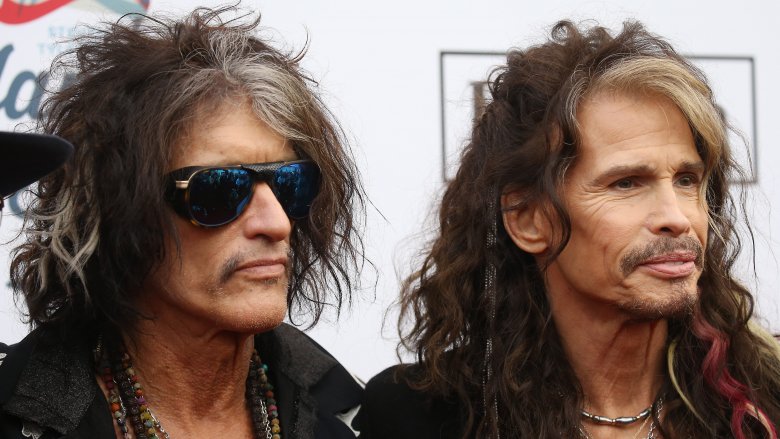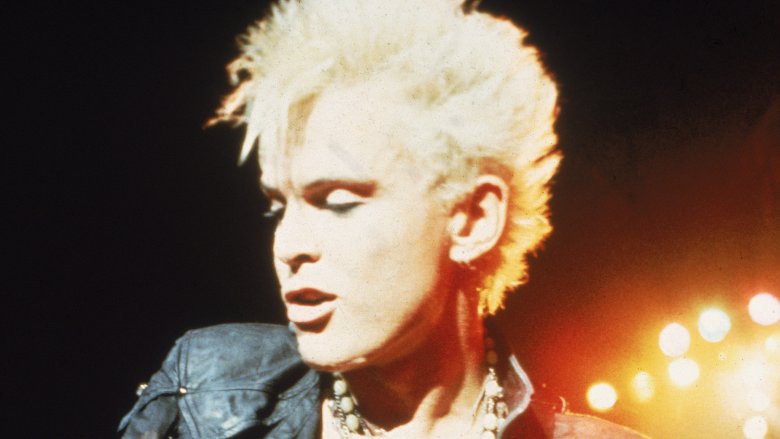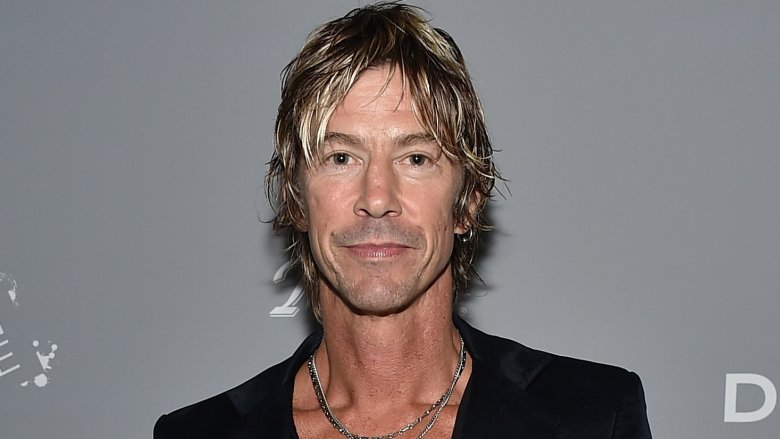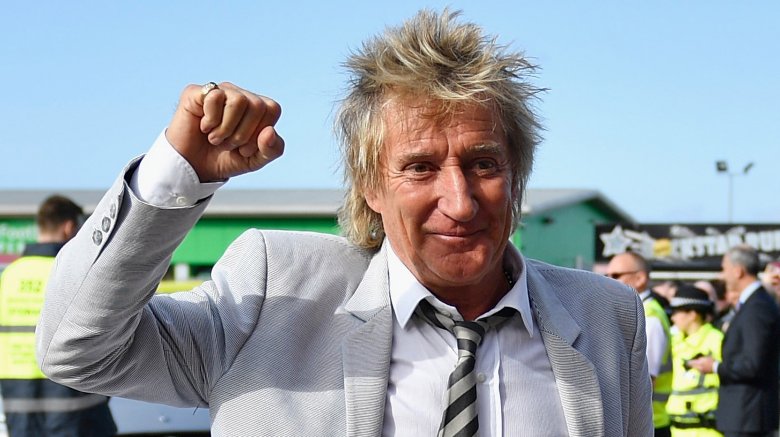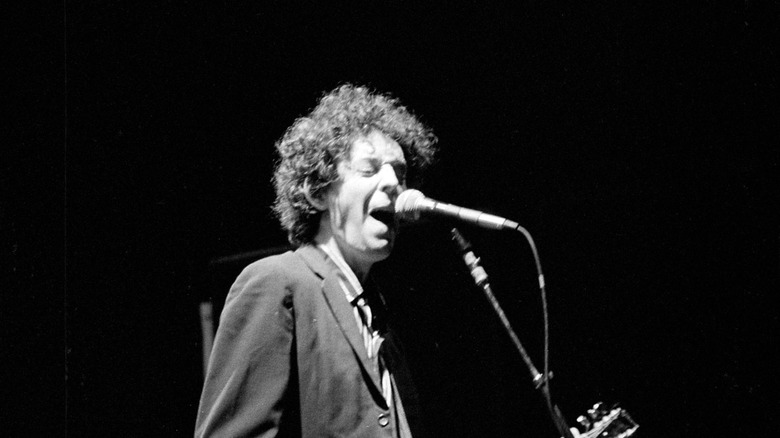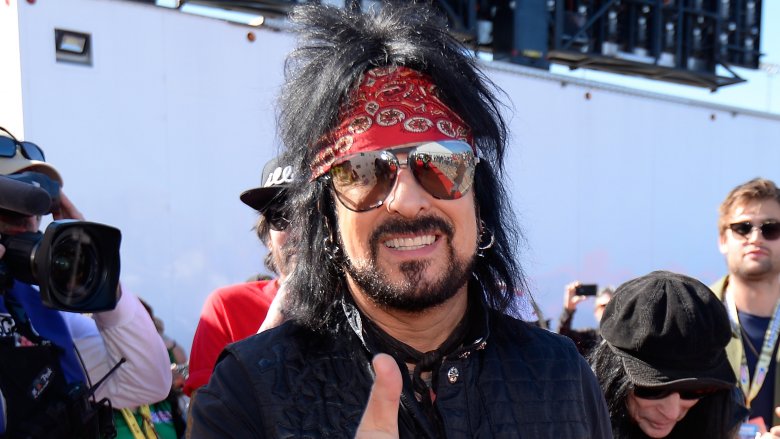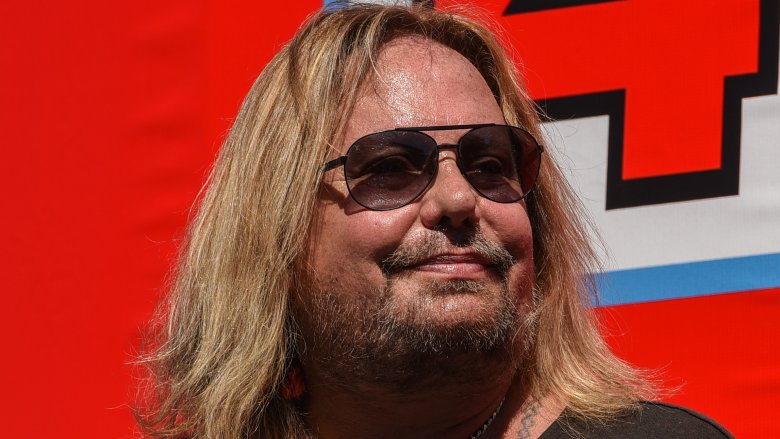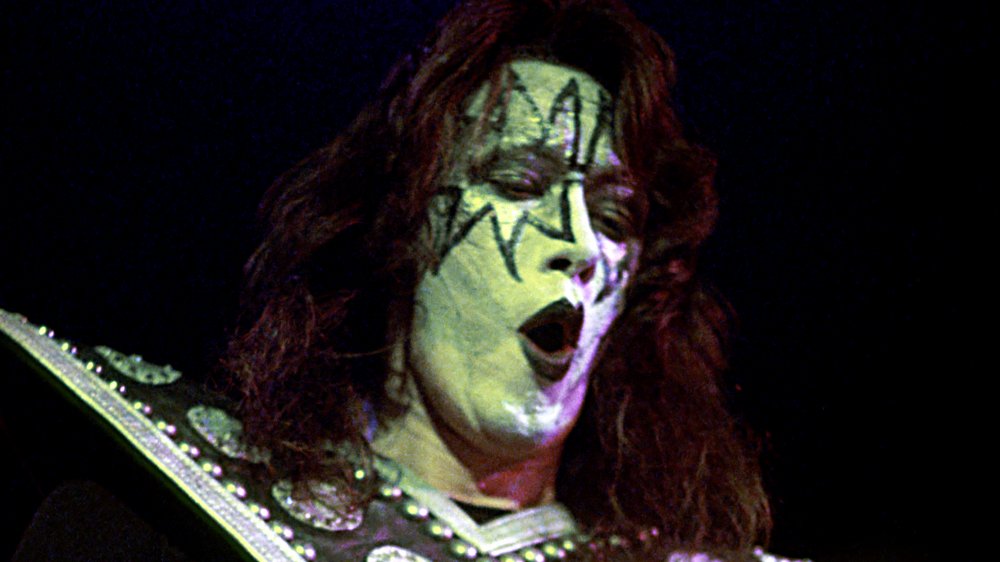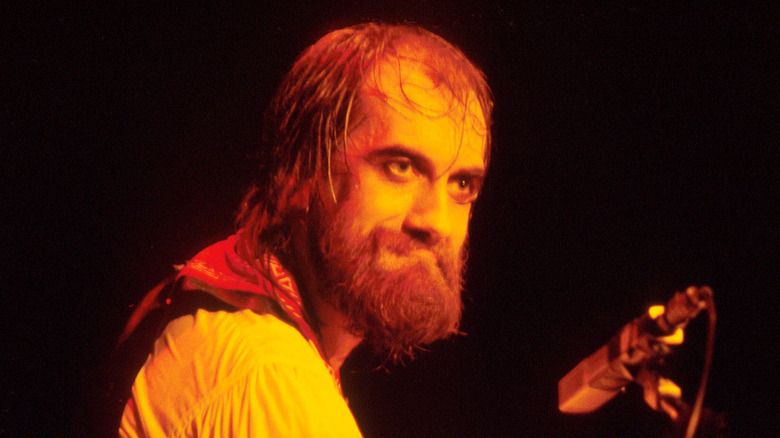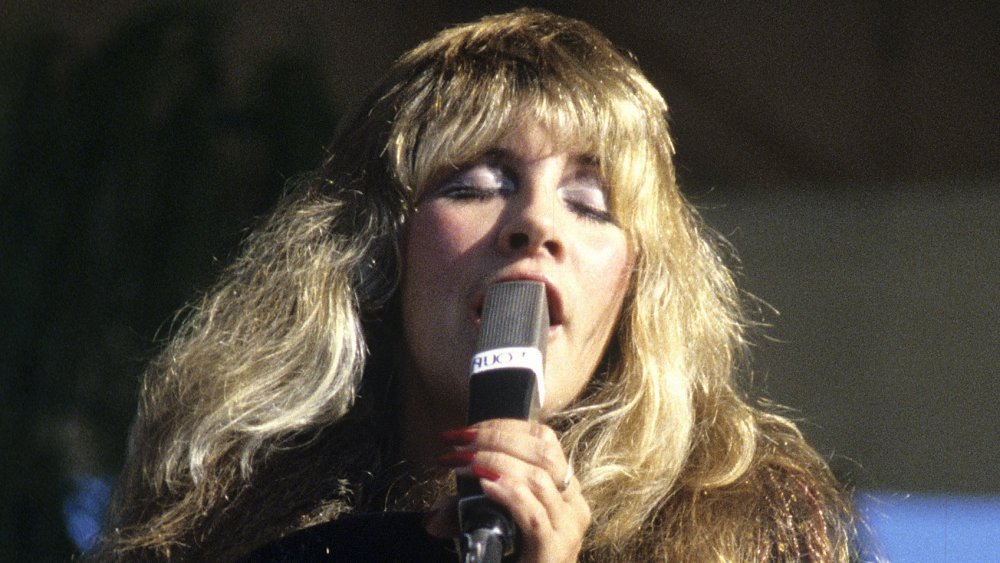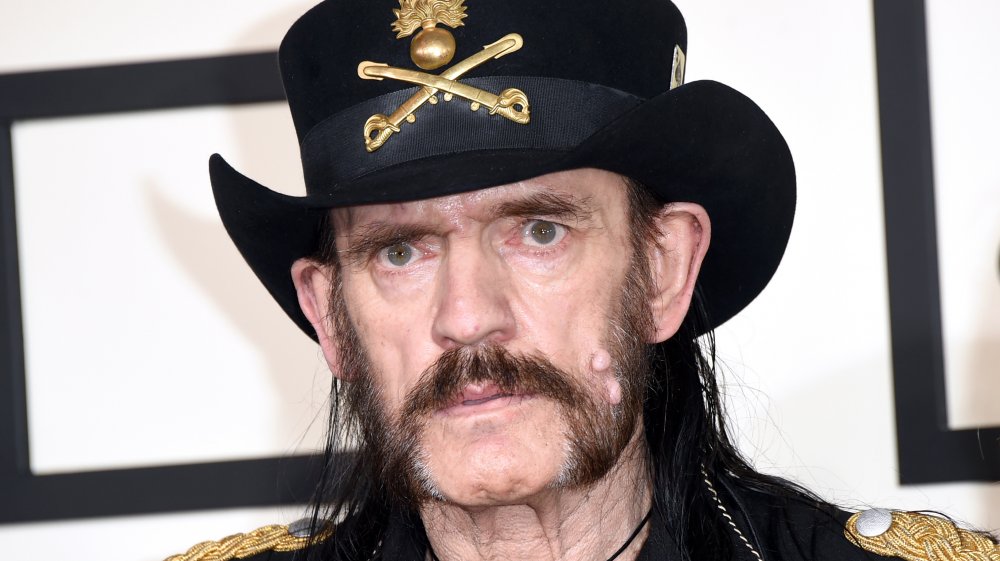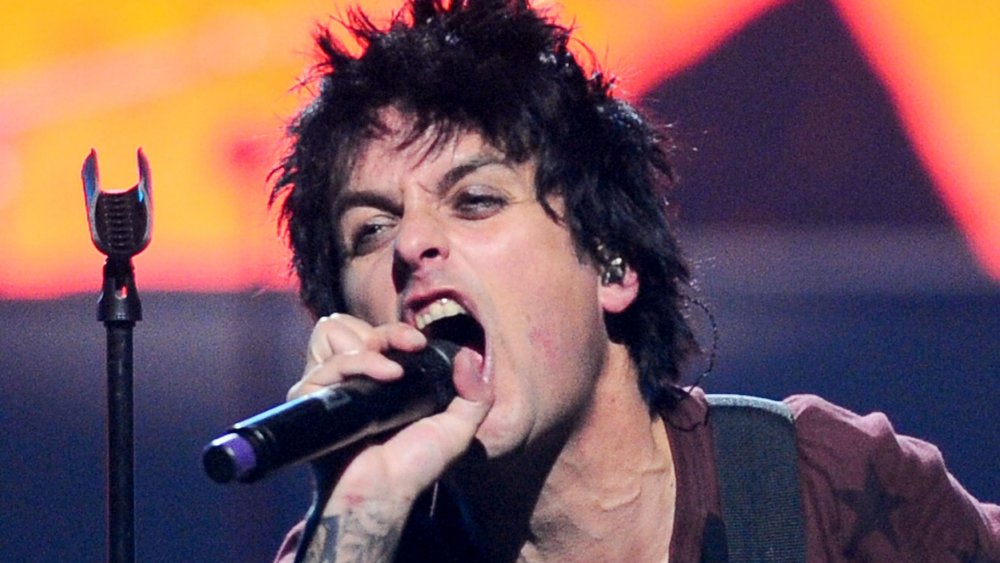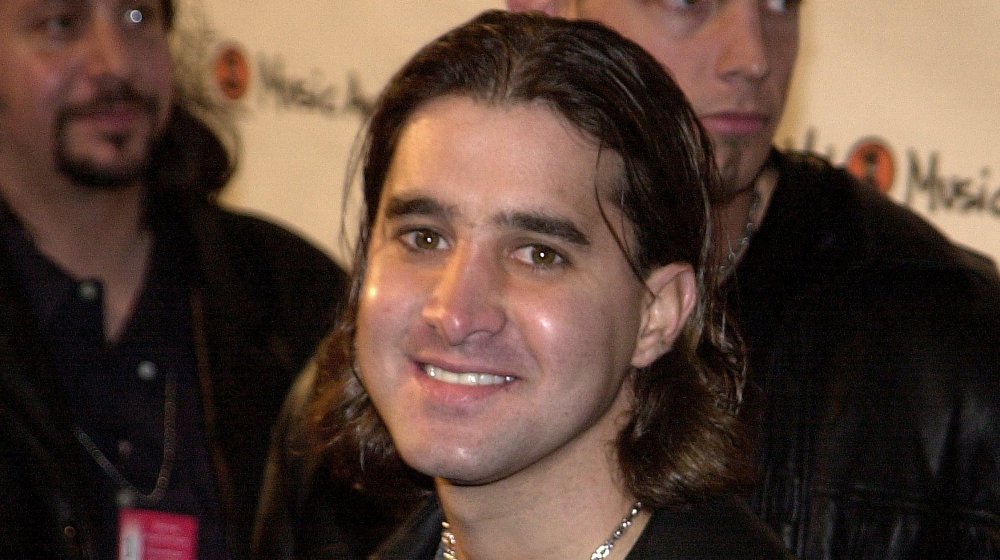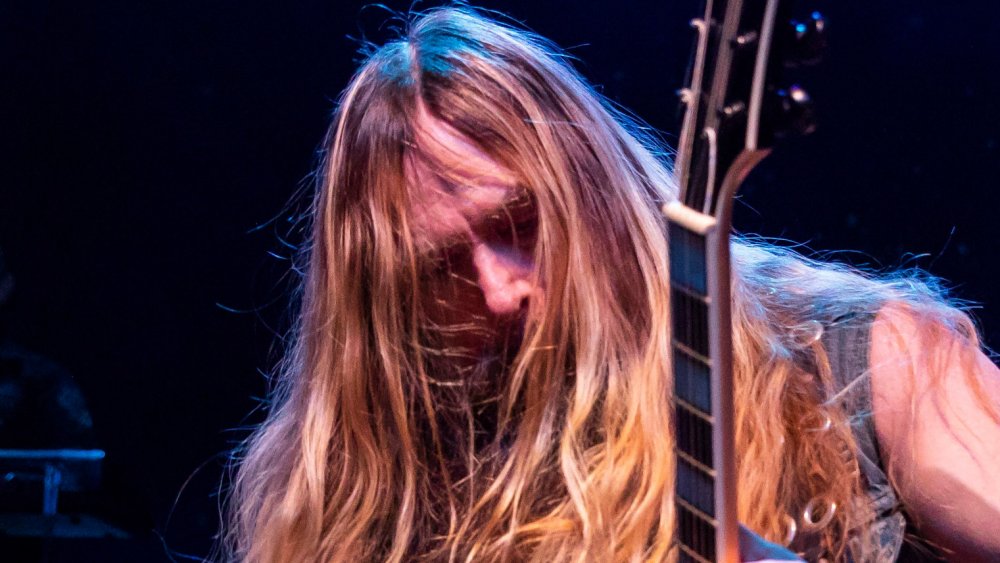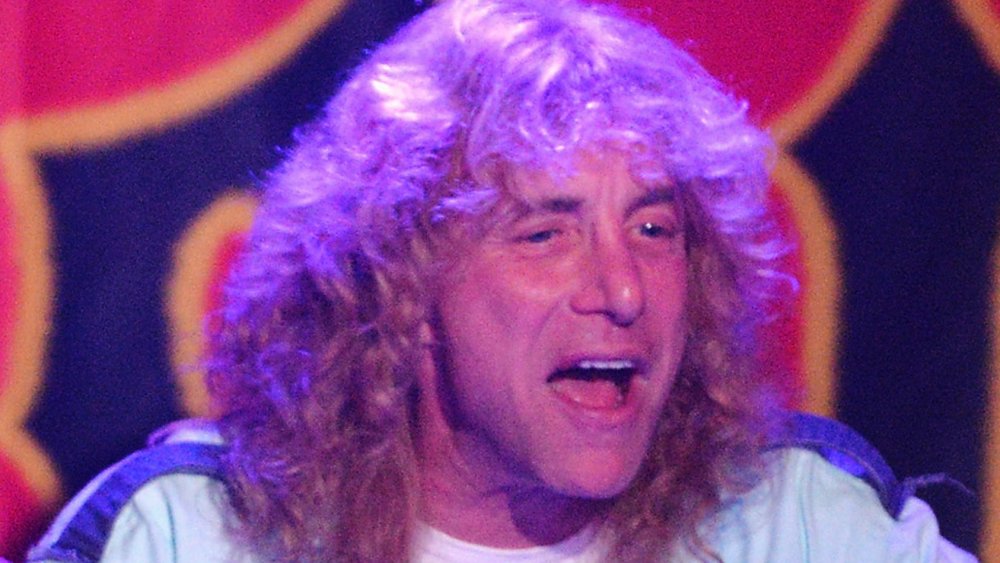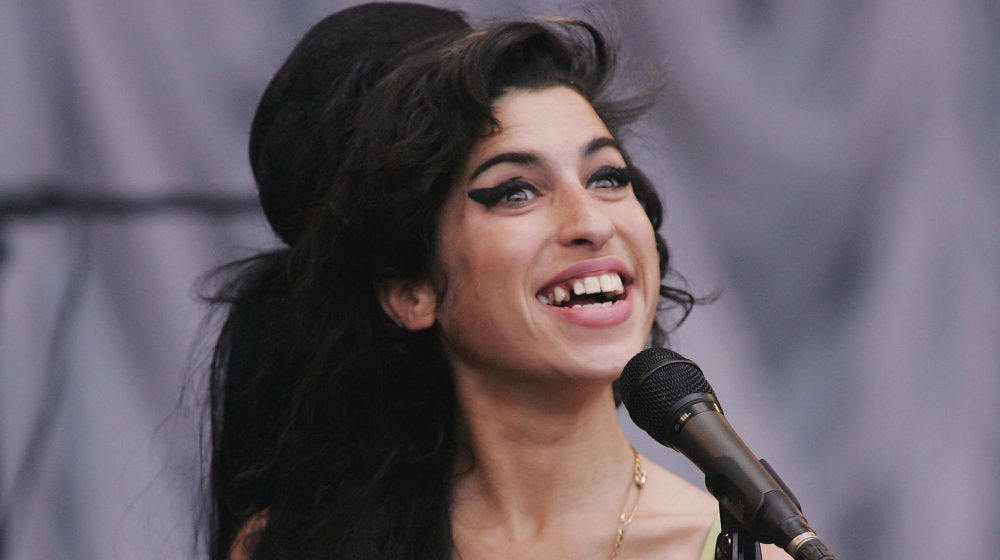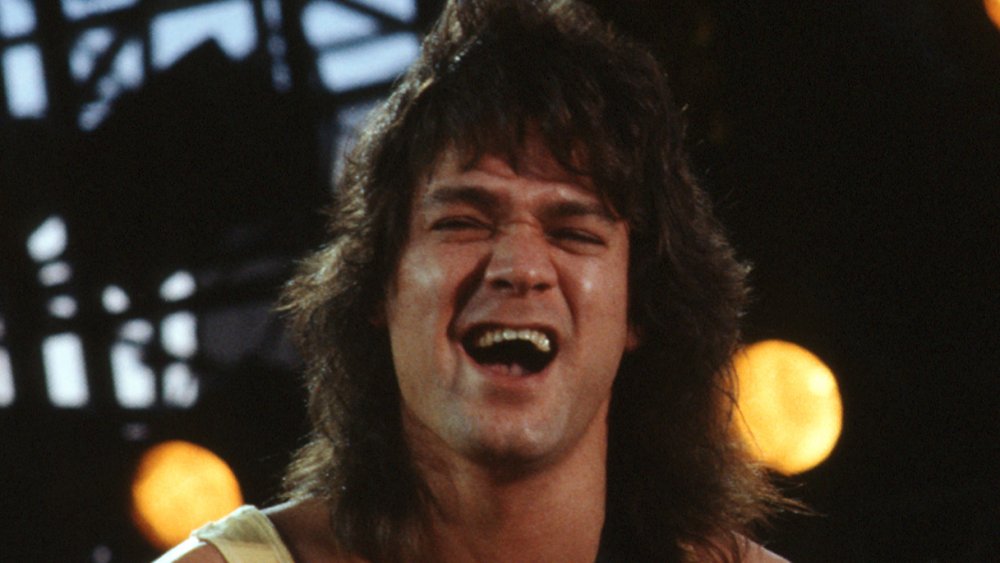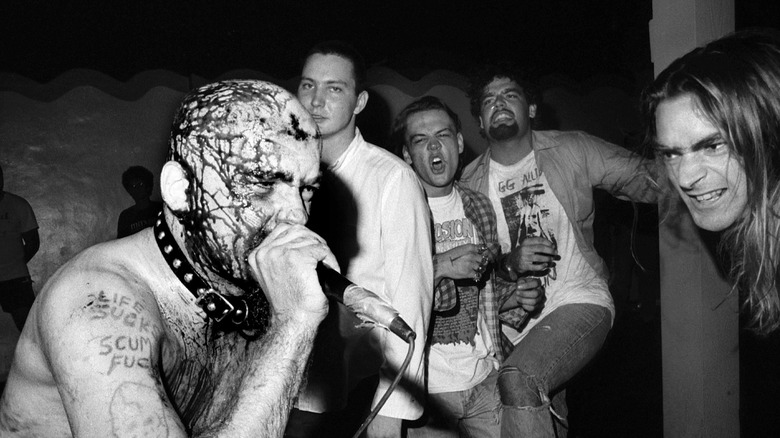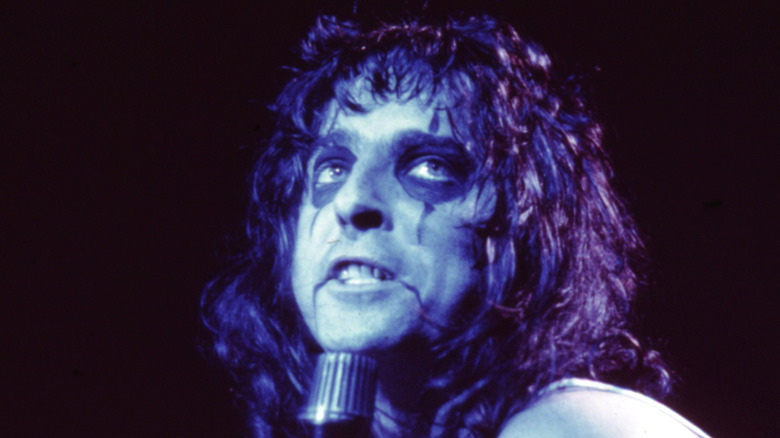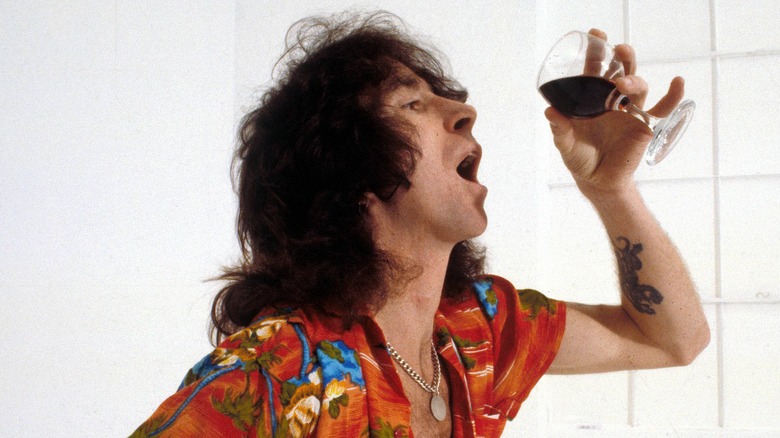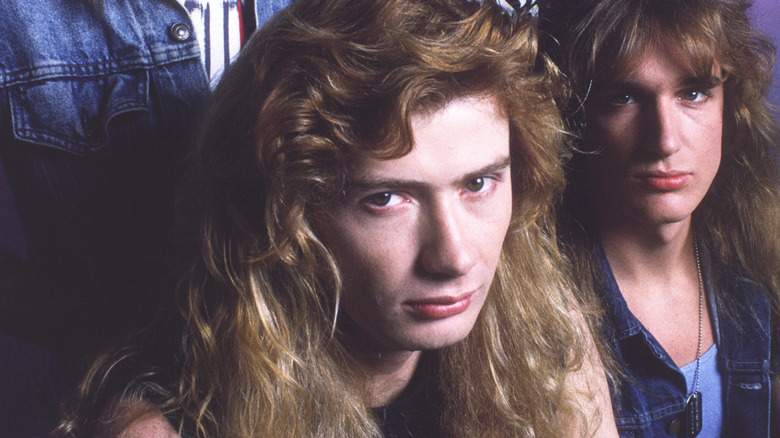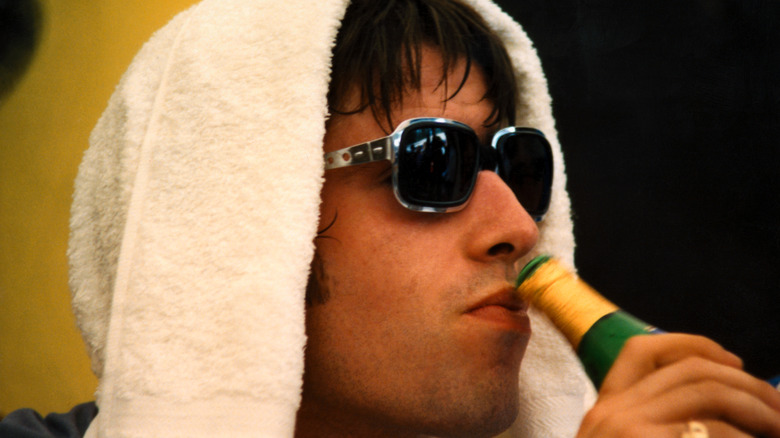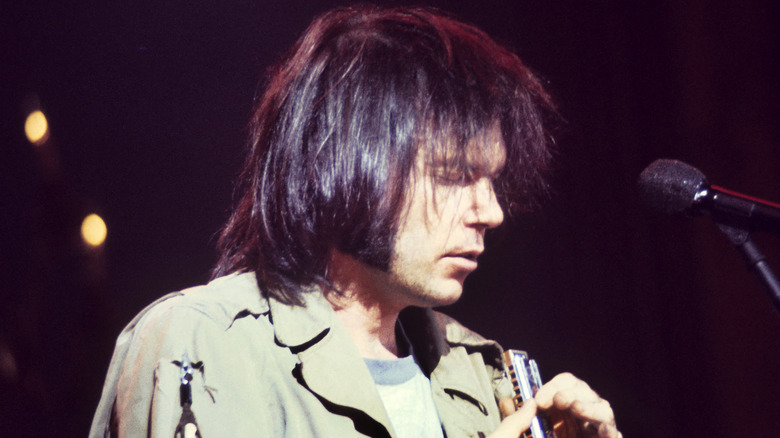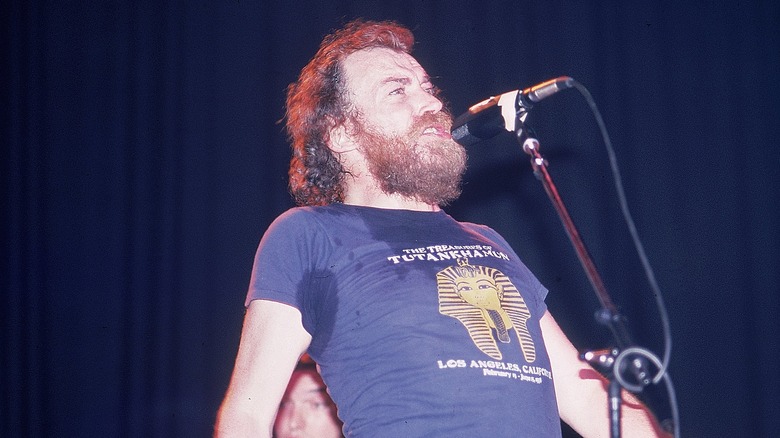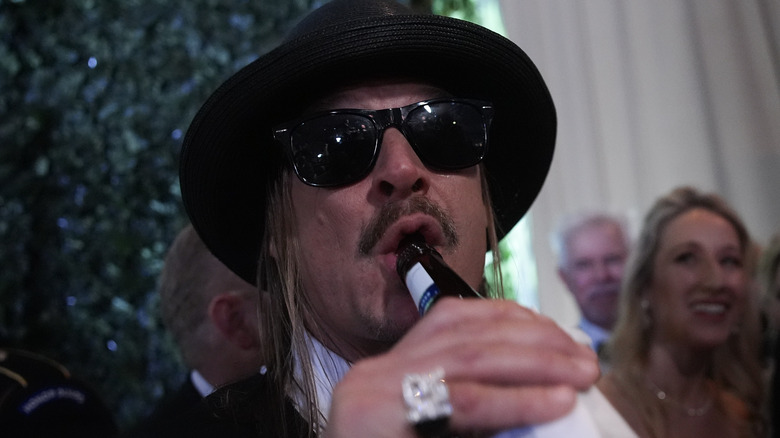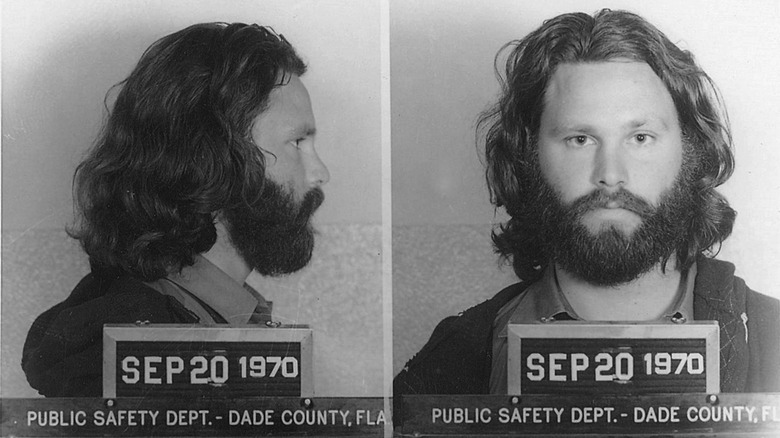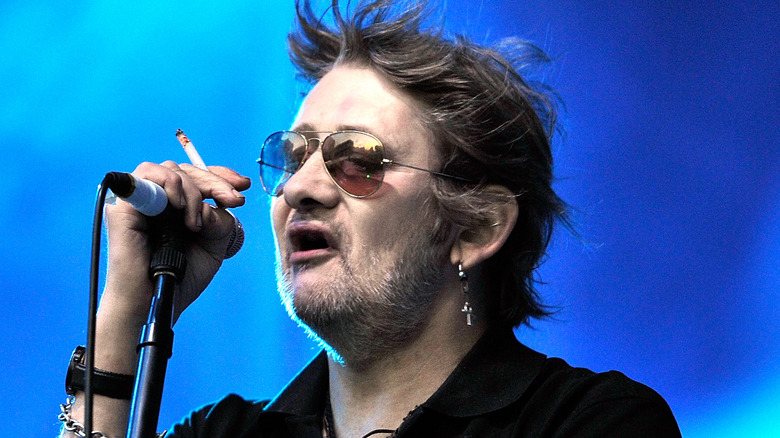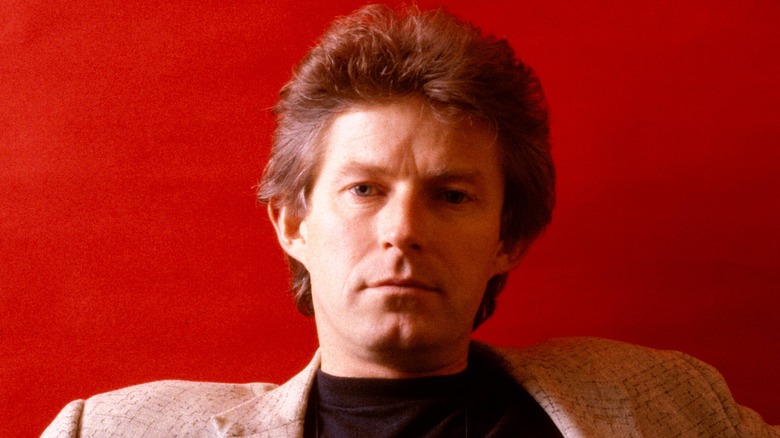Rockers Who Partied Way Too Hard
We may receive a commission on purchases made from links.
When you hear the words "rock star," you probably don't think about what it really takes to become a musical demigod. Nobody considers the guitar lessons, the early gigging in dingy bars, the cramped band vans, and going over the finer points of a recording contract with managers, lawyers, accountants, and label executives. Nah, "rock star" conveys images of flowing booze, endless drugs, groupies, trashed hotel rooms, and other unbelievably salacious and self-destructive practices.
There's a reason why rock stars are synonymous with excess in everything. More than some exaggeration or cliché, a lot of arena rock idols really lived that life, thus creating something to aspire to for the next generation of wannabe stars. Their exploits became the stuff of rumor, legend, and coroners' reports — because the danger in partying is the temptation to party too hard. Here are some rock stars who took the rock 'n' roll lifestyle a little far.
The Who's Keith Moon did what?
The Who's Keith Moon is almost objectively one of the greatest rock drummers of all time — Rolling Stone placed him at #2 on its list, and Modern Drummer said he's the eighth-best ever. Yet Moon is arguably more memorable for another rock 'n' roll achievement: He's the guy who made "trashing a hotel room" a quintessential part of the rock star experience.
Moon celebrated his 21st birthday in 1967 during a tour stop in Flint, Michigan. By the time he hit the stage that night, he'd been drinking all day ... but he was just getting started. Back at the local Holiday Inn, the Who threw a birthday party. Moon started a food fight, and then, while running around naked from the waist down, he tripped, fell, and knocked out half of a tooth. He was so drunk that the emergency dentist wouldn't give him any anesthetic for the repair surgery. Meanwhile, the party had descended into a riot, and the Who received a damages bill in the tens of thousands.
Moon also enjoyed personally ruining smaller rooms of other hotels. It was a tour habit of the drummer's to use cherry bombs and other small explosives to blow up hotel bathroom toilets. In 1978, and after a few hospitalizations, Moon attempted to quit drinking. A doctor prescribed him clomethiazole to help him deal with withdrawal symptoms and alcohol cravings. In a sad, ironic twist, Moon overdosed on the drug and died. He was 32.
Keith Richards is nothing to snort at
Maybe the most infamous hard partying hard rocker of all time, Keith Richards has defied modern medicine by still being alive despite his well-documented and copious drug use. Chasing a high has nearly killed the Rolling Stones guitarist a couple of times. He got heavy into heroin in the early '70s, and a few years later, he claimed to have been poisoned with strychnine-laced heroin. "I was totally comatose, but I was totally awake. I could listen to everyone, and they were like, 'He's dead, he's dead!' waving their fingers and pushing me about, and I was thinking, 'I'm not dead!'"
Now, it's hard to pinpoint the craziest thing Keith Richards did, but it's probably the time he inhaled his father's ashes up his nose. "I snorted my father," Richards told the NME. "He was cremated and I couldn't resist grinding him up with a little bit of blow. My dad wouldn't have cared, he didn't give a sh*t. It went down pretty well, and I'm still alive." Somehow, someway, yes. Science should probably look into that.
Ozzy Osbourne got so thirsty
Ozzy Osbourne is responsible for some of the most unbelievable rock legends of all time ... but most of them happen to be true. For example, he really did take a bite out of a bat on stage during a concert, and he was so drunk and annoyed during a record label meeting in 1981 that he bit the heads off a couple of live doves. And that's just what Ozzy does at work. When he was enjoying his personal time during his 1984 concert tour with Mötley Crüe as his opening act, he ingested so much alcohol and drugs it prompted him to perform some especially depraved and disgusting acts.
According to the Mötley Crüe memoir "The Dirt," band members and Ozzy were hanging out at a hotel pool in Lakeland, Florida. After asking for some cocaine and not receiving any, Osbourne took a straw and reportedly snorted a line of ants. (Osbourne's sideman, Jake E. Lee, remembers it differently, claiming the singer snorted a spider, not ants.) One gross act deserves another, and for Osbourne's next trick, in full view of "old women and families," he urinated all over the pool deck. It gets worse — he got down on the ground and "lapped it up." Wow.
John Bonham's fatal binge
Led Zeppelin generated a huge sound out of just four musicians, only three of whom played instruments. A big part of Zep's extremely influential, heavy sound is the thundering yet precise drum work of John "Bonzo" Bonham, who charged the band along as he pounded away on stuff like "Immigrant Song" and "Rock and Roll." And he was just as hard-charging in some of the non-musical parts of his life, too — particularly the drinking part. (They didn't call him "Bonzo," which rhymes with "gonzo," for nothing.)
Bonham was a heavy drinker, and not just in party or social situations. In late September 1980, Led Zeppelin convened at guitarist Jimmy Page's home in Windsor, England, for rehearsals. While working, Bonham helped him to quadruple vodka shots, one after another. The drummer imbibed somewhere in the area of 40 servings of alcohol and then ultimately passed out. At least, that's what he did according to a coroner's report. Bonham was so intoxicated that when his body tried to throw up all that toxic alcohol, he couldn't wake up, and he choked on his own vomit and died.
Aerosmith was too high to get down
Due to their love of illicit substances (particularly heroin and cocaine), wrecking hotel rooms, and frequent band infighting, Steven Tyler and Joe Perry — the braintrust behind Aerosmith — earned the nickname the Toxic Twins. The cred to back up that nickname was confirmed by no less than arguably the most drug-addled rock star of all time. "Jerry Garcia says that we were the druggiest bunch of guys the Grateful Dead ever saw," Tyler told Rolling Stone in 1990. "They were worried about us, so that gives you some idea of how f***** and crazy we were."
Tyler claims that he and some of his bandmates were so into that one rock 'n' roll excess that they didn't have the energy to indulge in the other. And that's something he regretted. "I'm still bummed out I didn't get all the sex I could have had in the Seventies," he said. "We were more interested in the finer blends of cocaine from a shipment of dates that came in on the back of some camel with the stamp of a half-moon on it and the star of Lebanon, which by the way was laced with opium," he later added.
Dave Navarro was too wild for the Playboy Mansion
For decades, the Playboy Mansion was literally party central. Playboy founder Hugh Hefner lived in the sprawling Los Angeles estate with any number of "Playmates," and high-profile guests came around most every night of the week to enjoy wine, women, and song. It was essentially a fancy flophouse, a comfortable place where celebrities could freely engage in whatever unrestrained debauchery they could imagine. And yet Dave Navarro, guitarist for Jane's Addiction and the Red Hot Chili Peppers, found some things that were too much for even the Playboy Mansion's unofficial "anything goes" policy.
In 2004, the guitarist published "Don't Try This at Home: A Year in the Life of Dave Navarro," recounting his exploits from 1998 to 1999. Therein, (via Spin) Navarro wrote about a visit to the Playboy Mansion's "orgy room" (apparently they have a dedicated space for that) with three women. While the women undressed and engaged in sexual activity, Navarro busied himself preparing and injecting a dose of heroin. With the blood that ran back into his trusty syringe, Navarro tried to write on the wall. While Navarro notes that he "cleaned it off," it still got him kicked out — and forever banned — from the Playboy Mansion.
Time to go, Billy Idol
British rocker Billy Idol took punk mainstream in the early 1980s. He had a punk background, and his pop-rock ("Dancing with Myself," "Rebel Yell") had a punk flair to it, but he really embodied the quintessential punk look with his spiked and bleached hair, leather jacket, and constant sneer. But while Idol may have been an '80s punk, he partied like an early '70s arena rock frontman.
While the likes of Led Zeppelin and the Who famously trashed hotel rooms, Idol absolutely destroyed the penthouse suite of The Oriental, a swanky hotel in Bangkok, Thailand. He took residence in the palatial quarters in 1989, staying for three weeks and refusing to leave. The entire time was a non-stop party full of booze, drugs, and women. It got so bad that Oriental management ordered him to leave ... but he wouldn't go. So, they called in representatives of the local military who shot him with a tranquilizer dart and carried him out on a stretcher. When it was all said and done, Idol received a bill for $250,000 worth of damages (and probably a couple of things from the minibar).
Duff had enough the rough stuff
Most of the stories about Guns n' Roses concern the band's iconic, notorious singer-lead guitarist combo in Axl Rose and Slash. But plugging away alongside them for years, both onstage and in the sordid annals of rock 'n' roll legend, was Duff McKagan. The GNR bassist celebrated and dealt with the pressures of his success with a one-two punch of cocaine and copious amounts of alcohol. McKagan routinely consumed a half-gallon of vodka daily — put another way, that's more than 40 shots of the stuff. At one point, McKagan realized that drinking so much vodka everyday probably wasn't so good for health, so he traded out spirits for wine — out went the half-gallon of booze and in came 10 bottles of red wine a day.
In the long run, that wasn't so good for him either, because in 1994, McKagan's pancreas burst. Doctors told him that if he were to have just one more drink, he'd die. "My mom had Parkinson's and I saw her come in crying, seeing her youngest son on tubes," McKagan told The Independent. "That turned me around."
Rod Stewart: What a pill!
Rod Stewart apparently faced a conundrum during his 1970s peak. He wanted to keep his signature, just-raspy-enough voice exactly as it was ... but he also wanted to enjoy the spoils of the success that voice brought him. In other words, how could Rod Stewart both sing his heart out every night for years on end but also ingest a small mountain of cocaine during the after-party? If he took it the old fashioned way, snorting lines of the stuff up his nose, that would damage nasal passages, his throat, and his famous voice. Fortunately for Stewart, there are other ways to get cocaine into the bloodstream.
"We started buying anticold capsules from the chemist's," Stewart wrote in "Rod: The Autobiography," "separating the two halves of the capsules, replacing their contents with a pinch of cocaine." Then that pill would go up his rear end, whereupon "they would dissolve effortlessly into the system." Yep — Stewart made and used homemade cocaine suppositories.
There was no replacement for Bob Stinson
The Replacements are alternative rock cult heroes for catchy, crunchy classics like "Can't Hardly Wait" and "I Will Dare." But the band is almost as legendary for its drinking. According to Bob Mehr's biography "Trouble Boys," the entire band frequently got hammered twice daily, once before a gig and then again when they got to the concert venue. In 1986, the band was so drunk for its performance on "Saturday Night Live" that guitarist Bob Stinson performed an inebriated somersault, tearing his pants and exposing his bare backside. After the show, the Replacements destroyed their hotel room, and "SNL" producer Lorne Michaels got the bill, prompting him to ban the band from the late-night program.
But even among the heavy-drinking Replacements, Bob Stinson apparently out drank everybody. Not long after the "SNL" incident, Stinson left the Replacements, and the other band members made him seek help for his substance abuse issues. "We paid for him to go into treatment, and he got out and scored some drugs that day," singer Paul Westerberg told the Pioneer Press. "It was obvious he didn't want to quit, or wouldn't. But we were no angels at the time, either. I think the spectacle sort of took over the band, and we forgot about playing music." Stinson kept up his hard-partying ways and in February 1995, the guitarist died of organ failure at the very young age of 35.
Nikki Sixx actually died
While the intoxicant of choice for the legendary Mötley Crüe's Vince Neil was alcohol, bandmate Nikki Sixx enjoyed harder pursuits. In 1983, Sixx crashed his Porsche and disclosed his shoulder in the accident. He got really into the painkillers doctors prescribed him, but those didn't do the trick for long. "Heroin began to consume me, first to kill the pain of the shoulder then later to kill the pain of life, which is the pain of not being on heroin," Sixx wrote in Mötley Crüe's memoir "The Dirt." By 1986, Sixx's heroin use was an open secret in the band's orbit, and his management team put him in a rehab center ... which he bailed on by jumping out of a second-story window.
On December 23, 1987, with his hair falling out due to his extensive drug use, Sixx enjoyed a night of cocaine ingesting with members of Guns N' Roses, Megadeth, and Ratt before retiring to a room at the Franklin Plaza Hotel, where Sixx's drug dealer injected him with a lethal dose of heroin. Yes, lethal. "Heroin nearly killed me," the bassist wrote in the Los Angeles Times. "As a matter of fact, it did." Sixx lost consciousness, and a friend called an ambulance. After being actually, clinically dead for two minutes, the guitarist sprang back to life thanks to two adrenaline injections administered by a paramedic.
Vince Neil got drunk, took a drive, and killed his friend
Most tales of rock 'n' roll debauchery end with the rock star passed out, more often than not in a destroyed hotel room surrounded by empty whiskey bottles. The events of December 8, 1984 are thus among the darkest days in rock history, and certainly the worst in the life of hard rock band Mötley Crüe — a time when the partying got so intense that it left a body count.
Crüe lead singer Vince Neil had been drinking at an LA area beach house for a few days almost totally uninterrupted. Late on the night of December 8, he decided to make a liquor store run to acquire more booze. However, he was already very intoxicated, and he took Hanoi Rocks drummer Razzle along for the ride. While driving down a winding road, Neil lost control of the vehicle and smashed into another car. While all parties were injured, Razzle got the worst of it — the 24-year-old was declared dead on arrival at a local hospital.
Kiss's Ace Frehley downed a bottle of perfume
In many ways, Kiss is the definitive rock band. Most of their songs are arena-filling rock 'n' roll anthems about rock 'n' roll ("Rock and Roll All Nite," "Detroit Rock City"), their stage show is full of pyrotechnics and special effects, and frontmen Gene Simmons and Paul Stanley strike the very image of the cocky, strutting rock star. And as they rock and rolled all nite, they also partied every day, particularly the band's longtime guitarist Ace Frehley (aka "The Space Ace"). In a 2019 interview with SiriusXM's Eddie Trunk (via Ultimate Classic Rock), Frehley revealed that he started drinking at the age of 13 and spent most of his life struggling with addiction before kicking his habits for good in 2006. His "moment of clarity," Frehley says, was when his daughter called him and called him out on how he'd started drinking again, imploring him to quit.
Frehley's drinking days included at least two audacious booze-fueled moments. In 1979, Kiss appeared on Tom Snyder's "Tomorrow" show, and a visibly intoxicated Frehley grumbled and drunkenly joked his way through it, to the annoyance of his bandmates, saying he was the band's "trout" player. And then there's the time when the band was riding in a limousine, and, upon spotting a bottle of perfume and being told it technically contained alcohol, Frehley chugged it, according to Rolling Stone.
Mick Fleetwood got seven miles high
After starting out as one of many British blues-rock bands in the 1960s, the legendary Fleetwood Mac became one of the biggest and most definitive soft rock groups of the 1970s. Its new sound, as heard on songs like "Dreams" and "You Make Loving Fun," was smooth, chill, and groovy, emblematic of the decade's upscale hippie/"California" vibe. And it totally belied how the group was fueled by cocaine.
According to drummer Mick Fleetwood's memoir, "Play On," he tried cocaine for the first time right around when Lindsay Buckingham and Stevie Nicks joined the group to record the 1975 album "Fleetwood Mac." As the band got bigger, the drugging increased, to the point where cocaine was purchased "in bulk," written off as an expense and handed out in packets to band and crew members alike each night.
Fleetwood once made a magazine's list of rock music's biggest spenders, specifically for how much money he'd spent on marching powder. The drummer spent somewhere in the area of $60 million. One night in the '90s, he and some associates determined exactly how much cocaine that was. Figuring he snorted an eighth of an ounce every day for 20 years, that works out to a line of cocaine of average thickness that's seven miles long.
Cocaine made a hole in Stevie Nicks' nose
Mick Fleetwood wasn't the only cocaine enthusiast in Fleetwood Mac. The group's enigmatic, distinctively voiced singer Stevie Nicks apparently once consumed cocaine with as much fervor as she brings to twirling while wearing shawls and singing spooky songs. "All of us were drug addicts," Nicks told Rolling Stone of her Fleetwood Mac associates. "But there was a point where I was the worst drug addict. I was a girl, I was fragile, and I was doing a lot of coke."
According to Zoë Howe's "Stevie Nicks: Visions, Dreams and Rumors," Nicks had spent roughly $1 million on cocaine by 1985. That's evidently enough blow to literally blow a hole through a nose — Nicks snorted so much that it left an interior opening and led to regular nosebleeds. By 1987, her body reacted to the constant influx of drugs (cocaine and otherwise) with blackouts and falls. When she sought a doctor, she was told that if she continued to snort cocaine at the rate at which she'd become accustomed, she'd suffer a brain hemorrhage or another fatal health defect. Still, Nicks didn't stop ("There was no way to get off the white horse and I didn't want to," she said) and only quit after seeking help at the Betty Ford Center following an intervention from her Fleetwood Mac cohorts.
Lemmy loved whiskey and speed
"Motorhead" is a slang term that means "a person who takes a lot of amphetamines." Motörhead was suitably named, then, because the group's frontman Lemmy Kilmister was a long-term amphetamine enthusiast. In his memoir "White Line Fever," Kilmister recalled the time in "'69 or '70" when he accidentally ingested what he thought was amphetamine but was really poisonous belladonna — and 200 times a fatal dose at that. He passed out and woke up in a hospital, where a doctor told him he was about an hour away from death had he not been treated.
In 1975, Kilmister was arrested at the Canadian-American border with amphetamine sulfate in his pants. After a night in jail, the charge was dropped — he was busted for cocaine, not speed, and was released on that technicality. Kilmister also liked booze, and he drank a bottle of Jack Daniel's every day for decades. As he aged, he had to scale back. "I don't drink much," he told Classic Rock (via Blabbermouth) in 2013, because the Coke he mixed with his whiskey "wasn't good" for his diabetes.
In his later years, Kilmister lived in Los Angeles, specifically a few blocks from the Rainbow Bar and Grill. He was such a frequent customer that after his death, the establishment held a memorial service (where the drink of choice was Kilmister's favorite, whiskey and Coke) and erected a statue of the singer.
Billie Joe Armstrong got drunk and angry onstage
Green Day has certainly evolved from its days as a sloppy Berkeley, California punk band. The power trio, led by singer and songwriter Billie Joe Armstrong, has created very un-punk things — a concept album ("American Idiot"), power ballads ("Wake Me Up When September Ends"), and Broadway musicals ("American Idiot: The Musical") — while retaining its punk spirit. The band's drummer, Tre Cool, still uses his historically punk stage name, for example, while Armstrong went full-on snotty, destructive, young-drunk-punk during a set at the 2012 iHeartRadio Festival.
Green Day was on a crowded bill that also featured pop stars like Taylor Swift and Rihanna. All acts were required to adhere to a performance schedule and were alerted that time in their set was running low via an onstage monitor. When such a "one minute remaining" message flashed up during Green Day's set, Armstrong came undone. He ended the group's set in favor of a profanity-laced tirade. "You're gonna give me f****** one minute? Look at that f****** sign right there. One minute!" Armstrong hollered. "I've been around since f****** nineteen-eighty-f******-eight. And you're gonna give me one f****** minute? You gotta be f****** kidding me!" Then he proclaimed that he wasn't Justin Bieber, smashed his guitar, flipped the bird, and stormed off. Armstrong later reflected on the incident in Rolling Stone, explaining that he'd been blackout drunk for the set, and shortly thereafter, he sought out professional help at a rehabilitation clinic.
Scott Stapp was so far gone he was sued by fans
In the early 2000s, Creed was one of the most popular bands in the world. The group, led by throaty singer Scott Stapp (whatever happened to him, anyway?), combined sludgy riffs with spiritually inspired lyrics and scored a ton of big hits, including "Higher," "One," and "My Sacrifice." Creed split up in 2004, and Stapp cited his wild behavior as the reason on an episode of "Oprah: Where Are They Now." That breakup was telegraphed by the band's December 2002 show at Allstate Arena in Rosemont, Illinois. According to a source who spoke to Blabbermouth, Stapp "was high out of his mind and could not sing," adding that he spent most of the set leaning against a riser, lying on his back, and "sweating like a pig."
Creed officially apologized. "The band has heard that you were unhappy with the quality of the recent Creed show in Chicago," the statement (via the Chicago Tribune) read. "We also understand and appreciate the fact that there has been much concern about Scott's health and we want to assure everyone that he is doing very well and is taking a much needed break."
It was such a terrible performance, with Stapp deemed visibly intoxicated by so many people, that fans sued. In April 2003, Wendy and Chad Costino and Philip and Linda Berenz sought legal help to get reimbursed for the cost of their tickets and parking fees (the lawsuit was later dismissed).
Heavy drinking somehow saved Zakk Wylde's life
Metal guitarist Zakk Wylde got his big break around 1987, when Ozzy Osbourne selected the 19-year-old New Jersey rock club regular to be part of his solo band. Wylde played on and wrote for a number of Osbourne records, and he also went on to form his own popular group, Black Label Society. Osbourne, one of rock's most legendary and prodigious drinkers, gave Wylde his start not just in the highest levels of music but in extreme partying, too. "That's when my drinking problem began," Wylde told SiriusXM (via Ultimate Classic Rock). "I drank until then, and then it was just double-fisting from that point on."
Wylde drank heavily into his early 40s, when he had to quit due to a blood disorder that caused clots to develop. If those travel to the heart or brain, they can be fatal, but Wylde's prolific drinking actually prevented his premature death. After developing severe leg and knee pain while on tour in 2009, Wylde was prescribed oral blood thinners to prevent blood clots. A mid-tour checkup included a CT scan, which revealed the presence of three clots that had already hit his heart ... and passed through safely. Alcohol also thins the blood, and a doctor believed that Wylde's years of drinking had successfully prevented large, deadly clots from forming.
Heroin nearly killed Guns N' Roses drummer Steven Adler
Guns N' Roses straddled serious hard rock and hair metal, a formula for staggering success — the group's 1987 debut, "Appetite for Destruction," sold 18 million copies in the U.S. alone. A big part of the group's sound was the thundering percussion of drummer Steven Adler, and he fully embraced the substance use element of the rock 'n' roll lifestyle. Adler had serious heroin use issues for seven years, during which he cheated death literally dozens of times (he was ultimately kicked out of Guns N' Roses).
At one point, he injected a speedball, a combination of heroin and cocaine. "I could feel my face hit the tile floor," Adler recalled in a book proposal. "I felt my teeth loosen as they broke away from the gums," he later added. "I felt the lacerations on my face. The last thing I remember was pounding my face into a pool of blood." Rushed to a hospital, Adler was diagnosed with his first stroke. He'd experience another heroin-induced stroke, along with a heart attack and approximately 31 hospitalizations for overdoses.
According to an interview with Blabbermouth, Adler was prescribed an opiate blocker in 1990, which made him violently ill due to the heroin still in his system. Days later, he was summoned to the studio to record with Guns N' Roses. He was so out of sorts that it took him about 25 takes to get his track somewhat right. That's when his "frustrated" bandmates kicked him out of the band.
Amy Winehouse drank herself to death
Singer Amy Winehouse emerged as one of the most celebrated new stars of the 21st century by making old music sound fresh. Evoking classic R&B, Winehouse packed a deeply soulful voice which she used to sing songs of love, heartbreak, and her struggles with substance abuse, as in her Billboard Top 10 hit "Rehab." Winehouse sold 16 million copies of "Back to Black" and won big at the 2008 Grammy Awards, taking home song of the year, record of the year, and best new artist. All that success was overshadowed by Winehouse's personal troubles, which included arrests for drug offenses, a viral video of the singer smoking what was reportedly crack cocaine, and an emphysema diagnosis.
Winehouse's demons tragically got the best of her. According to The Guardian, authorities were summoned to the singer's north London home in July 2011, where they found Winehouse and pronounced her dead at the scene. While Winehouse was reportedly a heroin user and initial reports of her death suggested the powerful opioid was involved, a postmortem inquest pinpointed a different cause of death. According to The Independent, a London coroner found no drugs in Winehouse's system, ruling that the singer died of alcohol poisoning following a period of three weeks of sobriety. Winehouse is believed to have consumed 416 milligrams of alcohol per deciliter of blood, well over a fatal level of 350 milligrams. The singer was 27 years old.
Eddie Van Halen struggled with alcohol for years
While original Van Halen lead singer David Lee Roth preferred to occupy his free time with cocaine, guitarist and band namesake Eddie Van Halen was way more interested in booze (and also cocaine). "I didn't drink to party," he told Billboard. "Alcohol and cocaine were private things to me. I would use them for work. The blow keeps you awake and the alcohol lowers your inhibitions." Van Halen's battle with the bottle started early: He began drinking regularly at age 12 and would show up drunk in high school. According to Rolling Stone, the death of his alcoholic father led him to briefly kick booze in the late '80s, but that was a relatively short period.
By 2004, Van Halen told Billboard, he'd become "an angry drunk," and that side of his personality manifested during a Tucson, Arizona, stop on a Van Halen reunion tour featuring singer Sammy Hagar. In "Red: My Uncensored Life in Rock," Hagar called it "the worst show we'd ever done in our lives." The reason: "Eddie played so bad. He smashed his favorite guitar to pieces. Sprayed shrapnel into the crowd." Then he grabbed a microphone and tearfully told the audience, "You don't understand. You people pay my rent. I love you people." That was the last time Hagar saw Van Halen, and he attributed the guitarist's problems to alcohol use issues, which he sought treatment for in 2007.
GG Allin kept the party going until it killed him
To call GG Allin a "punk rocker" is inaccurate — he was more of an extreme, confrontational performance artist with musical tendencies. Not content to simply scream his way through his loud, noisy brand of punk, Allin's live performances also included defecation (and doing unspeakable things with his own bodily waste), indecent exposure, self-harm, assaulting audience members, and equipment destruction. Allin's aggressive tendencies toward his own body extended to what he put inside it, as he was a heavy drinker and fervent user of drugs, particularly heroin.
According to fellow hardcore punk scene-ster and friend Michael Bowling, all of these behaviors coalesced on the evening of June 27, 1993. At the behest of punk singer and concert promoter Johnny Puke, GG Allin and the Murder Junkies played a show at a tiny Manhattan club, The Gas Station. The gig lasted just a few minutes before Allin got into a fistfight with an audience member. Moments later, he was lying in the street outside the venue naked. When police arrived on the scene, Allin (along with some audience members) fled into the nearby apartment of Johnny Puke, where he'd planned to party. Allin reportedly snorted a great deal of cocaine as well as heroin, and after passing out, he woke up at around 4:00 a.m. to snort more drugs. Later that morning, his friends discovered his lifeless body. He was 36.
Alice Cooper
In the 1970s, Alice Cooper was at his commercial and cultural peak. The man born Vincent Furnier, fronting the band also called Alice Cooper, imbibed alcohol with almost as much frequency as he shocked and entertained the masses with his gory, graphic, horror-inspired live shows. He consumed so much booze with so much regularity that one of his biggest ever binges served as a farewell to an alcohol-soaked lifestyle.
During the 1976 tour in support of the album "Welcome to My Nightmare," Cooper drank often. "Alcohol was my poison," he told Classic Rock. "I drank Seagrams VO, a Canadian rye, with Coca-Cola. And beer. For me, beer was like air. I'd have a six-pack before noon." Cooper was also a charter member of the Hollywood Vampires, a drinking club in L.A. consisting entirely of famous people, such as Keith Moon and Ringo Starr. "It was on the road — with all that dead time — when I would really drink too much," the singer-songwriter said. "I didn't have an off switch." Several times during the 1977 "Lace and Whiskey" tour, Cooper vomited blood. His wife observed, and with his manager, they put together an intervention. Later that year, after an all-night drinking session, he was admitted while hungover to Cornell Medical Center, a rehabilitation facility in New York.
Bon Scott
Even before he joined AC/DC, singer Bon Scott was known around the Adelaide, Australia rock scene for his prodigious drinking habits. In 1974, he showed up very drunk and very angry (following an intense argument with his wife) to a practice session for his pre-AC/DC band, the Mount Lofty Strangers. He kept drinking and tried to fight his bandmates until he finally left on his motorcycle. On the way, he crashed the vehicle and sustained a concussion and injuries to his throat, neck, nose, extremities, and collarbone. Scott lay in a coma for three days.
Scott continued his drinking habits unaffected, and on February 19, 1980, he met some friends at the Music Machine in London. Following several hours of continuous boozing, Scott could take no more but was so drunk and exhausted that he couldn't find his way home. So, he found a car parked near the Music Machine owned by a friend, and went to sleep. He never woke up — the next morning, the 33-year-old was found dead, covered in what was likely his own vomit, deceased for many hours. An autopsy determined that Scott died of an accidental overdose of alcohol. Beyond that, he was so drunk that he'd slept in an awkward position, wrapping himself around the shifting stick, which caused a dental plate to detach. He'd also developed hypothermia.
Dave Mustaine
In the early 1980s, Metallica's four members often drank copious amounts of alcohol, so much so that it earned itself the nickname "Alcoholica." But while James Hetfield, Cliff Burton, and Lars Ulrich tended to get wild and obnoxious when they drank, lead guitarist Dave Mustaine was different. "When you're around a lot of people that like to drink and get silly, they just want to have fun," Mustaine told Loudwire. "I would drink and have fun until someone would refute something I had said. And then that was war, baby. I'd be aggressive and confrontational because I was a violent drunk."
The rest of Metallica could only take so much. On the morning of April 11, 1983, the others abruptly woke the sleeping and very hungover Mustaine to tell him that he'd been fired from the group. Even worse: They'd been secretly working on finding a replacement, and they'd already hired a new guitarist, Kirk Hammett. "In retrospect, I get it: if you've got a guy that gets violent when he gets drunk, and he's kinda drunk 24/7 then having him around you all day long probably isn't good for business," Mustaine told Metal Hammer. "I would have done the same thing as Metallica did. I had a problem with alcohol, and it cost me my job and cost me two very dear friends."
Liam Gallagher
Oasis, as led by frequently-at-odds brothers Liam and Noel Gallagher, ruled the '90s British rock scene. By July 2000, the band was so popular that it filled London's gigantic Wembley Stadium for two nights. However, the group was starting to fracture under the weight of its own success: Two members had just left the band, Oasis had departed its label, and Liam was upset over his divorce and fighting with his brother even more than usual. He coped by self medicating, and he got himself very wasted before he took the stage for the first of the Wembley Stadium shows.
Gallagher hit the stage a bit early, wandering out during the set by opening act Happy Mondays to try to give that band's lead singer a hug. During Oasis' time, Gallagher repeatedly muttered bad words while singing and between songs and improvised insults directed at his former wife and his brother. In one moment, Gallagher refused to sing at all until some women in the audience obeyed his request to take off their shirts. When the concert mercifully ended, the rest of Oasis left the stage in a hurry, but Gallagher hung around, daring the audience to take off before he did. Gallagher later admitted that being drunk on stage was something he did as a habit, but he stopped after the 2000 Oasis shows at Wembley Stadium.
Neil Young
As influential as Bob Dylan was, combining rock, folk, blues, and country to make something brand new, so was the Band. After serving as Dylan's support musicians, the group broke out on its own in the late 1960s with "Music from Big Pink" and its self-titled LP. After nearly two decades as a unit, the Band decided to split in 1976, but not without a farewell concert on Thanksgiving Day with numerous high-profile special guests on the bill, including singer-songwriter Neil Young. He played "Helpless" with the Band, and the footage was included in "The Last Waltz," the 1978 concert film of the event directed by Martin Scorsese.
Immediately before he took the stage, Young had snorted a great deal of cocaine. The proof of that: The guitarist played "Helpless" seemingly without realizing that a big chunk of white powder rested in his nostril, fully visible, throughout the song. It was so unmistakable in the footage that Scorsese had to have the film carefully treated — with a new trick devised by his crew of editors — so that Yonge's cocaine-laden nose wouldn't show up in the movie.
Joe Cocker
In the late 1960s and early 1970s, Joe Cocker became a star by interpreting and reinventing already well-known songs of others through the prism of a bluesy, soulful growl. On stage, he transfixed audiences not just with his vocal performances but his wild, jerky, and unpredictable movements. It seemed to many that Cocker was intoxicated, and he often was. His regular ingestion of large amounts of drugs and alcohol added to the Joe Cocker experience.
While Cocker would attain sobriety in the early 1980s, it followed a spectacular flop of a concert in August 1974. After four years of not making much music, Cocker was primed for a comeback with a concert at Los Angeles' Roxy Theater in front of an audience stacked with pals, associates, and some of his biggest fans. "Mr. Cocker embarrassed and saddened his closest friends in the music business with a rambling, incoherent fiasco," wrote John Rockwell of The New York Times. Before the show began, Cocker reportedly drank so much booze that he vomited during the performance. He rallied enough to try to sing songs despite not remembering the lyrics and then took a seat on the ground and refused to perform his best-known song — a cover of the Beatles' "With a Little Help from My Friends."
Kid Rock
Throughout his musical output, Kid Rock has celebrated partying and hard drinking, but in the 2010s, he aligned himself with conservative politics. In 2024, Rolling Stone reporter David Peisner wanted to explore that shift, and he secured a 90-minute interview with the rap-rocker at the latter's estate near Nashville. That meeting lasted well into the night, with Kid Rock getting drunker, angrier, and more unpredictable as it progressed.
Kid Rock began the interview with sipping some white wine, then switched over to whiskey with Diet Coke while the political discussion grew more heated and disconnected in a lounge area adjacent to a home recording studio. "He proceeds to drain at least three or four of them in pretty quick succession," Peisner wrote. "He's sitting in a dark leather chair, shouting at me about something or other, when he reaches behind the seat, pulls out a black handgun, and waves it around to make some sort of point." Kid Rock mentions that he's got guns all over his property and that he isn't afraid to use them, and then he goes back to talking politics and peppering his remarks with the N-word. After making Peisner watch YouTube videos of his own performances, he fixed up another cocktail and made some racially-tinged remarks, challenged the reporter to a fight, and then drunkenly drove him back to his car on an all-terrain vehicle. Yikes!
Jim Morrison
About 10,000 fans filed into the Dinner Key Auditorium in Miami on March 1, 1969, for a performance by the Doors, led by charismatic if unpredictable lead singer Jim Morrison. Between songs, if he cared to sing them at all or just botched them, he slurred his way through spoken interludes. According to Rolling Stone, about an hour into the show, the visibly intoxicated Morrison reportedly yelled out, "Let's have a good time, let's have a revolution, everybody come up on stage," and then "Come up and touch me." Morrison also doused himself in champagne while welcoming around 60 fans up on the stage. "Do you wanna see my c***?" he then asked, apropos of nothing.
At that point, promoter Ken Collier took the microphone away from the singer and implored the audience to return to their seats. Meanwhile, Morrison shoved some fans around, reportedly mimed a sexual act, and allegedly withdrew his genitals from his pants. After more shoving (including knocking Collier's brother from the stage) and more screaming about the revolution, the concert was over when the promoter got the amps unplugged and the house lights turned on. As Morrison left the stage, witnesses claim he said, "Uh-oh, I think I exposed myself."
There was legal fallout for his actions. Local issues issued arrest warrants for Morrison on six charges, including indecent exposure, open public profanity, public drunkenness, and lewd and lascivious behavior. Though he was convicted and sentenced for indecent exposure, he was posthumously pardoned in 2010.
Shane McGowan
Shane MacGowan started the Celtic-rock band the Pogues, and the rest of the group fired him in 1991 because his addictions made him so unreliable. MacGowan began regularly drinking at the age of 5, when his parents gave alcohol to him. "You soon get used to two bottles of Guinness a night," he said of his nightly bedtime ritual in "A Drink with Shane MacGowan." By the time he was 8, MacGowan had moved away from beer in favor of whiskey at the urging of an uncle. He once claimed that he was almost constantly drunk from the age of 14 onward, and later in adulthood, he'd added heroin to his regimen of substances.
MacGowan's voracious use of alcohol, heroin, and other substances led directly to him losing all of his teeth. His last real one fell away in 2008, he wore dentures for seven years, and he got implants in 2015, a year before he found sobriety. In 2023, he died of pneumonia at age 65.
Don Henley
Following a monumental run in the 1970s, which spawned two of the top four best-selling albums of all time in "Their Greatest Hits 1971-1975" and "Hotel California," the Eagles split up in 1980 amid major band tension. Breaking the news to the band's crew fell to singer and drummer Don Henley, who invited everyone over to his home in Los Angeles on November 20, 1980. After everyone departed, Henley felt so low and defeated that he telephoned a procurer and arranger of sex workers to dispatch someone. "I wanted to forget what was going on. I wanted to escape the depression I was in," Henley testified in Manhattan Supreme Court in 2024 during a separate legal matter when questioned about his past criminal activities (via the New York Post). "And a few hours later, a young woman arrived at my home," he later added.
After exchanging some pleasantries, Henley and the young woman had some wine, and he brought out some cocaine upon request. After that, they went to sleep, and several hours later, Henley was awakened by loud sounds and found his companion in the middle of a seizure. The musician called 911, and paramedics revived the woman — the seizure was the symptom of an overdose of cocaine. When the woman left Henley's house later on, police arrested Henley, and he was charged with contributing to the delinquency of a minor (the former Eagle claimed to have no idea that the sex worker was 16 years old).
Following a monumental run in the 1970s, which spawned two of the top four best-selling albums of all time in "Their Greatest Hits 1971-1975" and "Hotel California," the Eagles split up in 1980 amid major band tension. Breaking the news to the band's crew fell to singer and drummer Don Henley, who invited everyone over to his home in Los Angeles on November 20, 1980. After everyone departed, Henley felt so low and defeated that he telephoned a procurer and arranger of sex workers to dispatch someone. "I wanted to forget what was going on. I wanted to escape the depression I was in," Henley testified in Manhattan Supreme Court in 2024 during a separate legal matter when questioned about his past criminal activities (via the New York Post). "And a few hours later, a young woman arrived at my home," he later added.
After exchanging some pleasantries, Henley and the young woman had some wine, and he brought out some cocaine upon request. After that, they went to sleep, and several hours later, Henley was awakened by loud sounds and found his companion in the middle of a seizure. The musician called 911, and paramedics revived the woman — the seizure was the symptom of an overdose of cocaine. When the woman left Henley's house later on, police arrested Henley, and he was charged with contributing to the delinquency of a minor (the former Eagle claimed to have no idea that the sex worker was 16 years old).
If you or anyone you know needs help with addiction issues, help is available. Visit the Substance Abuse and Mental Health Services Administration website or contact SAMHSA's National Helpline at 1-800-662-HELP (4357).
If you or someone you know may be the victim of child abuse, please contact the Childhelp National Child Abuse Hotline at 1-800-4-A-Child (1-800-422-4453) or contact their live chat services.
If you or someone you know needs help with mental health, please contact the Crisis Text Line by texting HOME to 741741, call the National Alliance on Mental Illness helpline at 1-800-950-NAMI (6264), or visit the National Institute of Mental Health website.
